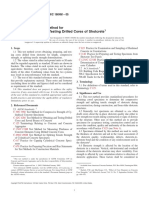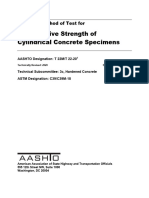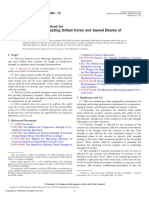Job-Task Analysis (JTA) For ACI Concrete Strength Testing Technician Certification
Job-Task Analysis (JTA) For ACI Concrete Strength Testing Technician Certification
Uploaded by
samuelCopyright:
Available Formats
Job-Task Analysis (JTA) For ACI Concrete Strength Testing Technician Certification
Job-Task Analysis (JTA) For ACI Concrete Strength Testing Technician Certification
Uploaded by
samuelOriginal Title
Copyright
Available Formats
Share this document
Did you find this document useful?
Is this content inappropriate?
Copyright:
Available Formats
Job-Task Analysis (JTA) For ACI Concrete Strength Testing Technician Certification
Job-Task Analysis (JTA) For ACI Concrete Strength Testing Technician Certification
Uploaded by
samuelCopyright:
Available Formats
Job-Task Analysis (JTA) for ACI Concrete Strength Testing Technician
Certification
How TO USE TRIS JTA:
For each of the following assessment methods, the Candidate must:
On the written examination:
• Understand the following general concepts, which may not have specified values, procedures, or
measurements; and
• Know the following specific procedures or values; perforrnance of these items rnay also be assessed
on the performance examination.
On the performance examination:
• Perform—or describe verbally, where allowed—the following tasks or steps, which are part of the
specified procedure; knowledge of these items may also be assessed on the written examination.
RESOURCES:
ASTM C617/617M – Standard Practice for Capping Cylindrical Concrete Specimens
ASTM C1231/1231M – Standard Practice for Use of Unbonded Caps in Determination of Cornpressive
Strength of Hardened Concrete Cylinders
ASTM C39/39M – Standard Test Method for Compressive Strength of Cylindrical Concrete Specimens
ASTM C78/78M – Standard Test Method for Flexural Strength of Concrete (Using Simple Beam with
Third-Point Loading)
ASTM C617/617M – Standard Practice for Capping Cylindrical Concrete Specimens
• Understand scope of practice
• Understand significance and use of practice
• Know dimensional requirernents of capping plates
• Know criteria for sulfur melting pots
• Understand use of Table 1 for strength and thickness requirements of capping rnaterials
• Understand requirements for qualification of high-strength gypsurn plaster
• Understand requirements for qualification of sulfur mortar caps
• Know and perforen the procedures for capping hardened concrete specimens
• Know how to protect and store specimens after capping
• Understand safety issues related to rnelting pots
• Know the requirements for and perform alignment check of cylinders
• Know and perforen the procedure for planeness check of caps, including the proper reporting of
results
• Know and perform the procedure for thickness measurements of caps, including the proper reporting
of results
ASTM C123111231 M — Standard Practice for Use of Unbonded Caps in Determination of
Compressive Strength of Hardened Concrete Cylinders
• Understand scope of practice
• Know compressive strength lirnits for the use of unbonded caps
• Understand significance and use of unbonded caps
• Know dimensional, material, and hardness requirements of elastomeric pads
• Know dimensional, material, and planeness requirernents of pad retainers
• Know requirements governing the use of elastomeric pads
• Know the requirements for and perform perpendicularity check of concrete cylinder ends prior to test
• Know the limits for and perform check for depressions in concrete cylinder erids prior to test
• Know requirernents for the use of unbonded caps in combination with other capping rnethods
• Know wear requirements for pads and perform exarnination for excessive wear
• Know and perform the procedures for centering, initial loading, arid checkirig specirnens for
perpendicularity
• Know and perforen the procedures for loading, testing, and calculation per Test Method C39/C39M,
including the proper reporting of test results
Page 1 of 3 Approved 4/16/2013
Job-Task Analysis (JTA) for ACI Concrete Strength Testing Technician
Certification (Continued)
• Understand methodology used to qualify the use of unbonded caps for various strength levels and to
qualify the permitted number of pad reuses
• Understand the use of calculations used in qualification testing for computing the difference in
strength for each pair of cylinders and computing the average strength of cylinders tested using
unbonded caps and the reference capping system
• Know the mínimum percentage of reference capping system strength that rnust be met to qualify
unbonded caps for use
ASTM C39/39M – Standard Test Method for Compressive Strength of Cylindrical
Concrete Specimens
• Understand scope of test method
• Understand summary of test method
• Understand significance and use of test method
• Understand calibration requirements of testing machine
• Understand design requirements of testing machine
• Understand accuracy requirements of testing machine
• Understand general requirements for bearing blocks
• Understand requirements for bottom bearing blocks
• Understand requirements for upper spherically-seated blocks
• Understand requirements for load-indicating dials
• Understand requirements for digital load indicators
• Know requirements for allowable variance in cylinder diameter
• Know requirements for and perform check of perpendicularity and planeness of cylinder ends
• Know the requirements for determining daily average diameter
• Understand the requirements for deterrnining density of test specimens (when requested)
• Know the requirernents for conducting length measurements
• Know the requirements for maintaining specimens in a moist condition until time of test
• Understand the permissible time tolerances for testing
• Know and perform the procedure for positioning and centerirtg specimens in the machine
• Know and perform the procedures for zeroing the machine and aligning upper bearing block
• Know and perform the procedure for applying the test load at the proper rate
• Know and perform the procedures for applying the load to failure and identifying break type
• Know and perform the calculation of test results, including the proper reporting of compressive
strength
• Know how to correct strength values for a given length-to-diameter ratio
• Know which information is to be included on reports
ASTM C78/78M – Standard Test Method for Flexura) Strength of Concrete (Using Simple
Beam with Third-Point Loading)
• Understand scope of test method
• Understand significance and use of test method
• Understand general requirernents for testing rnachines
• Understand requirements for third-point loading apparatus
• Know requirements for dimensions, shape, and surface conditions of test specimens
• Understand technician qualification requirements
• Know requirements for testing moist-cured specimens
• Know and perforrn the procedure for positioning specimens on support blocks, including checking and
correcting for gap widths at contact points
• Understand how to calculate loading rate
• Know and perform the procedure for applying the test load at the proper rate
• Know and perform the procedure for measuring specimens for average width and depth after
specimen fracture
• Know and perforrn the calculation of modulus of rupture when fracture occurs in the middle third of
the span length
Page 2 of 3 Approved 4/16/2013
Job-Task Analysis (JTA) for ACI Concrete Strength Testing Technician
Certification (Continued)
• Know and perform the calculation of modulus of rupture when fracture occurs outside the middle third
of the span length
• Know the information to be included on reports
• Know and perform the reporting of modulus of rupture with proper precision
Page 3 of 3 Approved 4/96/2093
You might also like
- Jeremy MacClancy - Exotic No More - Anthropology On The Front Lines (2002)100% (4)Jeremy MacClancy - Exotic No More - Anthropology On The Front Lines (2002)475 pages
- Bulk Material Handling: Practical Guidance for Mechanical EngineersFrom EverandBulk Material Handling: Practical Guidance for Mechanical Engineers5/5 (1)
- C42 - C42M-20 Standard Test Method For Obtaining and Testing Drilled Cores and Sawed Beams of ConcreteNo ratings yetC42 - C42M-20 Standard Test Method For Obtaining and Testing Drilled Cores and Sawed Beams of Concrete7 pages
- Aggregate Testing Technician Level 2 PDFNo ratings yetAggregate Testing Technician Level 2 PDF130 pages
- ACI JTA Concrete Strength Technician PDFNo ratings yetACI JTA Concrete Strength Technician PDF3 pages
- Job Task Analysis (JTA) For ACI Concrete Field Testing Technician - Grade I CertificationNo ratings yetJob Task Analysis (JTA) For ACI Concrete Field Testing Technician - Grade I Certification3 pages
- Abul Kalam Azad Civil Engineering Departmentprof., King Fahd Univ of Petroleum & MineralsNo ratings yetAbul Kalam Azad Civil Engineering Departmentprof., King Fahd Univ of Petroleum & Minerals46 pages
- Abrasion Resistance of Concrete or Mortar Surfaces by The Rotating-Cutter MethodNo ratings yetAbrasion Resistance of Concrete or Mortar Surfaces by The Rotating-Cutter Method4 pages
- ASTM D 5035 Breaking Strength Elongation StripNo ratings yetASTM D 5035 Breaking Strength Elongation Strip1 page
- CIP35 - Testing Compressive Strength of ConcreteNo ratings yetCIP35 - Testing Compressive Strength of Concrete2 pages
- Rock Bolt Anchor Pull Test: Standard Test Method For0% (1)Rock Bolt Anchor Pull Test: Standard Test Method For6 pages
- Astm C-39 Standard Test Method For Compressive Strength of Cylindrical Concrete Specimens100% (2)Astm C-39 Standard Test Method For Compressive Strength of Cylindrical Concrete Specimens14 pages
- Student Manual For Strain Gage Technology: Vishay Measurements Group, IncNo ratings yetStudent Manual For Strain Gage Technology: Vishay Measurements Group, Inc48 pages
- 346 Tubing and Hose System Maintenance Course DescriptionNo ratings yet346 Tubing and Hose System Maintenance Course Description1 page
- ASTM D 5034 Breaking Strength/Elongation Grab MethodNo ratings yetASTM D 5034 Breaking Strength/Elongation Grab Method9 pages
- C39-16b COMPRESSIVE STRENGTH OF CYLINDRICAL CONCRETE SPECIMENSNo ratings yetC39-16b COMPRESSIVE STRENGTH OF CYLINDRICAL CONCRETE SPECIMENS7 pages
- Flexural Strength of Concrete (Using Simple Beam With Third-Point Loading)No ratings yetFlexural Strength of Concrete (Using Simple Beam With Third-Point Loading)4 pages
- Splitting Tensile Strength of Cylindrical Concrete SpecimensNo ratings yetSplitting Tensile Strength of Cylindrical Concrete Specimens5 pages
- AASHTO T22M (2020) - Compressive Strength of Cylindrical Concrete SpecimensNo ratings yetAASHTO T22M (2020) - Compressive Strength of Cylindrical Concrete Specimens12 pages
- ASTM-C-42 - Obtainig and Testing Drilled Cores and Sawed Bemas of Concrete100% (1)ASTM-C-42 - Obtainig and Testing Drilled Cores and Sawed Bemas of Concrete8 pages
- Flexural Strength of Concrete (Using Simple Beam With Third-Point Loading)No ratings yetFlexural Strength of Concrete (Using Simple Beam With Third-Point Loading)4 pages
- Obtaining and Testing Drilled Cores and Sawed Beams of ConcreteNo ratings yetObtaining and Testing Drilled Cores and Sawed Beams of Concrete7 pages
- Standard Test Method For Rock Bolt AnchoNo ratings yetStandard Test Method For Rock Bolt Ancho6 pages
- Mock Up of Tube To Tubesheet Joints in Shell and Tube Heat ExchangersNo ratings yetMock Up of Tube To Tubesheet Joints in Shell and Tube Heat Exchangers4 pages
- Well Interventions: Completion Design & Slick Line/Coiled Tubing Well Interventions TechniquesNo ratings yetWell Interventions: Completion Design & Slick Line/Coiled Tubing Well Interventions Techniques4 pages
- Prompting Science and Engineering Students in Practical TrigonometryFrom EverandPrompting Science and Engineering Students in Practical TrigonometryNo ratings yet
- Turning and Boring A specialized treatise for machinists, students in the industrial and engineering schools, and apprentices, on turning and boring methods, etc.From EverandTurning and Boring A specialized treatise for machinists, students in the industrial and engineering schools, and apprentices, on turning and boring methods, etc.No ratings yet
- Graded Aggregate Material For Bases or Subbases For Highways or AirportsNo ratings yetGraded Aggregate Material For Bases or Subbases For Highways or Airports3 pages
- Standard Test Method For - Heptane Insolubles: Designation: D3279 - 07No ratings yetStandard Test Method For - Heptane Insolubles: Designation: D3279 - 074 pages
- Penetration of Bituminous Materials: Standard Test Method ForNo ratings yetPenetration of Bituminous Materials: Standard Test Method For4 pages
- Sampling Aggregates: Standard Practice ForNo ratings yetSampling Aggregates: Standard Practice For6 pages
- Statistics For The Behavioral and Social Sciences A Brief Course 5th Edition Arthur Aron Download PDF100% (5)Statistics For The Behavioral and Social Sciences A Brief Course 5th Edition Arthur Aron Download PDF84 pages
- Universidad Nacional de Ingenieria Facultad de Ingenieria MecanicaNo ratings yetUniversidad Nacional de Ingenieria Facultad de Ingenieria Mecanica12 pages
- New MCQ on Section 1 of ISO 9001:2015 Quiz100% (1)New MCQ on Section 1 of ISO 9001:2015 Quiz27 pages
- Radical Innovation Across Nations: The Preeminence of Corporate CultureNo ratings yetRadical Innovation Across Nations: The Preeminence of Corporate Culture21 pages
- Decision Making and Negotiation: Take Home Test: Analyzing Negotiation ExperienceNo ratings yetDecision Making and Negotiation: Take Home Test: Analyzing Negotiation Experience5 pages
- Play Like A Champion: A Content Analysis of Coach Behavior in Sport Films Since Title IXNo ratings yetPlay Like A Champion: A Content Analysis of Coach Behavior in Sport Films Since Title IX12 pages
- Siemens PLM LMS Transfer Path Analysis Troubleshooting Fs - tcm1023 233710No ratings yetSiemens PLM LMS Transfer Path Analysis Troubleshooting Fs - tcm1023 2337102 pages
- Using Importance-Satisfaction Analysis (ISA) To Identify The Most CriticalNo ratings yetUsing Importance-Satisfaction Analysis (ISA) To Identify The Most Critical8 pages
- Exploring Data-MC Practice: Use The Data For Questions 1 - 5No ratings yetExploring Data-MC Practice: Use The Data For Questions 1 - 52 pages
- Consumer Behavior Towards Online Marketing: Dr. Mohan Kumar TP, Shiva Shanthi SNo ratings yetConsumer Behavior Towards Online Marketing: Dr. Mohan Kumar TP, Shiva Shanthi S5 pages
- Chapter 5: Sampling Distributions & Hypothesis TestingNo ratings yetChapter 5: Sampling Distributions & Hypothesis Testing19 pages
- Measure of Relativity Position Normal Distribution CorrelationNo ratings yetMeasure of Relativity Position Normal Distribution Correlation22 pages
- Distribution and Retrieval of SLM New Template GeraldNo ratings yetDistribution and Retrieval of SLM New Template Gerald20 pages
- Brief Composition: Review in No More Than 200 Words. Submit Your Composition Through This PeerNo ratings yetBrief Composition: Review in No More Than 200 Words. Submit Your Composition Through This Peer2 pages
- Experiences of Dynamic Bullying VictimsNo ratings yetExperiences of Dynamic Bullying Victims19 pages
- A Practical Approach To Survey Sampling For Reseachers and Post GraduatesNo ratings yetA Practical Approach To Survey Sampling For Reseachers and Post Graduates12 pages


































































































